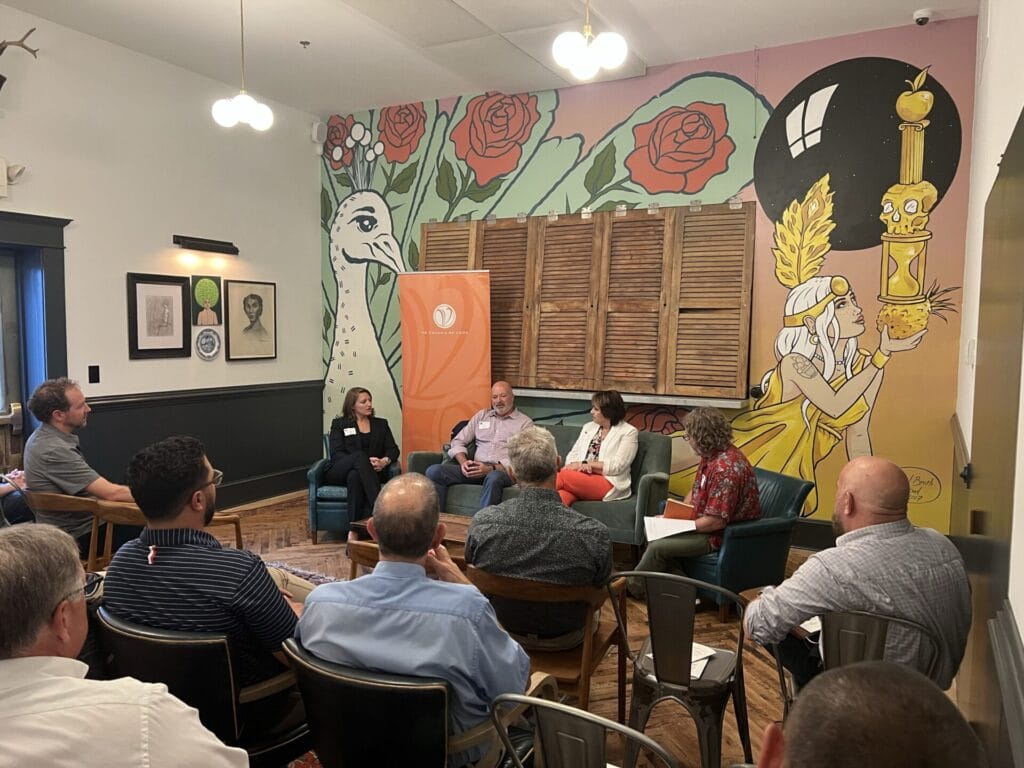What Makes Peer Groups Great: Summary of a Qualitative Analysis of Executive Peer Groups
Introduction
Executive peer groups, like those facilitated by the Virginia Council of CEOs (VACEOs), play a significant role globally, with over 100,000 executives involved in various organizations such as EO, YPO, and Vistage. The VACEOs alone boasts over 200 CEO members across Virginia. These groups operate under strict rules emphasizing confidentiality, candor, vulnerability, and a protocol of experience sharing over advice-giving. Meetings generally follow a structured agenda featuring updates on professional and personal challenges, followed by presentations on key issues, where members share their experiences under the guidance of a facilitator. Additionally, annual retreats blend business and leisure, further fostering group cohesion.
Despite their prevalence, little research has explored why some executive peer groups outperform others. These groups’ confidential nature makes external study challenging. However, Mike Matthews, a long-term VACEO member and past chair, leveraged his insider access to conduct research to understand the factors contributing to the success of some peer groups over others.
Participants
To explore why certain executive peer groups thrive, Matthews employed a qualitative research method focusing on the top-performing groups within VACEOs. He selected 35 members from the four highest-ranked groups, as determined by annual member surveys. These surveys asked members to rate various aspects of their group experience on a 10-point Likert scale. They provided a Net Promoter Score by inquiring how likely members were to recommend VACEOs to others. Participation in the study was voluntary, with assurances of confidentiality to ensure honest and open feedback.
Discussion
The analysis of focus group transcripts revealed several key themes: Camaraderie, Safe Environment, Whole Person, Training, Protocol/Process, and Culture.
Camaraderie emerged as a critical element, with participants highlighting the importance of openness, experience sharing, and vulnerability in building trust and commitment within the groups.
Training is provided initially and recommended annually by VACEOs. While not all groups adhere to the annual training, those that do tend to operate more effectively, suggesting the importance of regular training in maintaining group performance.
Group Forming involves creating the group and onboarding new members, establishing norms, expectations, acceptable behaviors, boundaries, and the group’s purpose. Consistency in these processes contributes significantly to group effectiveness.
A Safe Environment is crucial, with members expressing a high degree of trust in the confidentiality of their shared information. This trust fosters connectedness, belonging, and a willingness to share vulnerabilities, strengthening group cohesion.
Culture encompasses the beliefs, values, expectations, assumptions, and perceptions guiding behaviors within the group. High-performing groups often exhibit cultural norms such as punctuality, preparation, compliance with bylaws, and adherence to procedures.
Additional Observations
Other noteworthy observations include recognizing members as Whole Persons, and acknowledging that CEOs face personal and professional challenges. Participants described the peer group as a support system for all aspects of life, not just business, enhancing the holistic well-being of members.
The concept of Protocol and Process was also prevalent. Groups follow established protocols and processes, with effectiveness often waning as time passes from the last training. These protocols provide a structure for regulation and conflict resolution through processes like “clearing the air,” where members address interpersonal issues directly.
Leadership was another recurring theme. High-performing groups typically have influential leaders who guide the group and set the tone. Whether through regular rotation or longer tenures, reliable leadership is crucial for maintaining group performance.
Conclusions
The success of high-performing peer groups is attributed to a combination of Camaraderie, Training, Group Forming, Safe Environment, and Culture. The integration and consistent practice of these elements drive group success. The concept of “fit,” where multiple activities interact and reinforce one another, is central to this success. For instance, a safe environment enables camaraderie, periodic training upholds a culture driven by protocol, and the absence of any of these elements weakens the group’s effectiveness.
The economic benefits of participating in these groups, in terms of both time and money, are seen as invaluable by members. However, without the consistent practice of all these components, the benefits could diminish, potentially making the costs outweigh the gains. Effective leadership and the support mechanisms of the larger organization are crucial in sustaining these high-functioning peer groups.
Mike Matthews has been a member of the Virginia Council of CEOs since 2009, having served as board chair, board member, and committee chair. He is currently pursuing a Ph.D. in Organizational Leadership. This article summarizes a research paper Mike developed on Group Behavior. His findings were reported to the VACEO board for consideration and were presented at the 2024 International Conference on Management, Leadership, and Business Intelligence in Houston, Texas. The full research paper is available by contacting Mike at MMatthews@PSMJ.com.
Member Profile: Amy Baril of twotango collaborative
Q: Where did you grow up and tell us a little about yourself.
A: I grew up in the best city in the world, Richmond, VA. I attended Virginia Commonwealth University (Go Rams), and I am a boomerang Richmonder, having moved away for a little over a decade, then moving back with my husband and daughter.
Q: Please tell us about your journey to become a CEO.
A: I never aspired to be a CEO, but sometimes opportunities come to you that are too good to let pass. I started my career as an assistant media buyer at Circuit City Stores, moving then to The Martin Agency, McKinney, Blue Cross Blue Shield North Carolina and then to NDP advertising agency, (Now Two Tango Collaborative). At Two Tango, I had the opportunity to move up in the agency from Media Director to VP of Media, to President and now CEO. I love everything about being a CEO, the challenges of learning, running a business, and connecting with other leaders, the opportunities to give back to an amazing city and to create a place where people love to work.
Q: How are you promoting leadership development at twotango collaborative?
A: Every year we ensure that we provide opportunities for growth. Whether that is seminars, conferences, courses or serving the community on boards our team may love. It is a priority to give back to our team. We also promote from within first, and then look outside of our firm if needed.
Q: Are you working on any new business ideas?
A: Yes, being a Collaborative* is by design. We do not just do advertising; we are constantly providing solutions that go beyond the normal advertising agency. Shhhhh don’t tell, but we have more on the horizon.
Q: Are there any national/business authors that you follow? What is it about them or their message that resonates with you?
A: I am a huge fan of Mel Robbins. She has an inspirational story of perseverance and to never give up. She also provides a balance of data with the human factor in business, life, community and the journey of life. Her messages are backed by science, not just ‘fluff’. I also enjoyed Who Says Elephants Can’t Dance: Inside IBM’s Historic Turnaround by Lou Gerstner. A great book about the transformation of IBM’s business and its evolution in the early 1990’s to become a critical consultant business model. In my field, change is constant, so understanding how to stay ahead and evolve is critical.
Q: When you are not leading twotango collaborative, what do you like to do?
A: I love music, everything about it. I love going to shows and looking around to see 10,000 that normally would never be in the same space, but this one thing brought us all together, no matter your background, value system, race, religion, sexuality… you are all there to share in an experience.
I love spending time with family and friends chilling in our back yard around the fire pit, going to movies, eating out (have I said how amazing Richmond is with the restaurant scene).
Q: You attended our Fall Leaders Conference with your team. Do you or your team have a takeaway from the experience?
A: “Isn’t that awesome” is something we still say. We came away feeling rejuvenated in how to engage with our clients, and each other. To ask the tough questions in a different way. To stay focused on what really matters.
Q: Tell us how you are involved in the community.
A: I am President of the American Marketing Association of Richmond, a volunteer board with the purpose of sharing, learning and networking with Richmond’s great marketing minds. I am also on the board of rvaTech Foundation that supports STEM Education and Community Development.
Q: Since you’ve been a member of VACEOs, how have you grown as a CEO?
A: I came into VACEOs with an open mind, not sure what to expect and in short form was thrilled to have a community where I could be open, honest and supported. I have learned many other CEOs have the same challenges, have walked in my shoes so to speak and just ‘get it’. Which has been valuable to me. I have also learned I have much to offer to other CEOs through my diverse career and experiences.
Next Session of Roundtable Program for Key Executives Begins in February 2025
Key Executive Roundtables is our peer learning experience for “second in commands.” We created a peer learning experience for COOs, GMs, number twos, etc., two years ago and have run two annual sessions. We are ready to announce our third Key Executive Roundtable program, to begin February 2025!
Learning with peers accelerates the abilities of professionals. We know that from decades of serving CEOs in this way.
VACEOs is offering a cohort-style program for key executives from small and medium sized businesses that will:
- Create meaningful connections with other professionals. A trusted network.
- Accelerate the learning and growth of these professionals by expanding their perspectives and exposing them to others’ experiences.
- Connect them with experts from the community in a wide range of disciplines.
The next session of Key Executive Roundtables will form roundtables of 8 to 12 executives, who will meet every other month from February to October 2025. These three-hour meetings will be led by a professional facilitator and consist of two elements.
- A confidential peer roundtable experience that gives everyone the chance to share issues and opportunities, and to learn from one another’s experiences. Essentially, a condensed version of our CEO Roundtables format. Participants are expected to commit to 100% attendance.
- Learning from subject matter experts on topics like strategy, execution, culture, technology, compliance, finance, HR, marketing, sales, etc.
For non-meeting months, the group will be encouraged to meet informally with funds available for social meetings.
This is not a VACEOs membership, but a program that we are offering to key executives of both member and non-member firms. Key Executive participants will not be included in VACEOs events.
Cost for this program is $2,600 for VACEOs members’ key execs, and $2,850 for execs from non-member organizations. Fees are billed after acceptance. Commitment to attend all 5 meetings is required.
You can apply here. Deadline for applications is December 15.
$100 off for applications received by November 1.
If you have any questions, please email info@vaceos.org.
Rather Listen than Read? Podcast Recommendations from Top Virginia Executives

We know that leaders are readers, but increasingly, leaders are listeners! We asked for podcast recommendations from the VACEOs community. Comment and share your favorites.
P.D. Love, president of CRC, shared a bunch.
- For industry info (FinTech, general technology) I listen to The WealthStack Podcast, In Depth, WealthTech On Deck, and Masters of Scale
- Health and Fitness include Huberman Lab, The Drive (Peter Attia), The Human Upgrade (Dave Asprey), and Tim Ferriss Show (with some great interviews as well)
- Good interviews (when I see a guest I like) from Joe Rogan, Lex Fridman.
- Business/Motivation topics The School of Greatness (Lewis Howes), Business Wars and The Kevin Rose Show
These keep my commute, walking and other listening time full. Haven’t needed the radio in years!!
I love This American Life. It’s exceptional and very eclectic. Funny, touching, educational, inspiring, and always interesting, it’s a roll of the dice!
Bryant Harrison, Seventh Wall
I listen to a lot of podcasts but here are the 5 I rarely miss. – Robin Green, Sandler
- All In — Four Silicon Valley buddies who rif, argue, and cover big topics in tech and politics.
- No Laying Up – all that is happening in the world of golf. A group of college buddies who have irreverent takes on the golf world.
- History That Doesn’t Suck – history made interesting.
- The Learning Leader – interesting topics from authors and thought-leaders.
- Acquired – Deep dive stories of industry titans. These are like books – but fascinating backstories on top companies.
I never miss an episode of The 21 Hats Podcast. Loren Feldman, whose business journalism experience includes Inc.com, New York Times, and Forbes, convenes a panel of small business owners for frank discussion and experience sharing on a question or topic. It’s almost like a public CEO Roundtable. Loren also curates a daily newsletter and some events. He’s worth following.
Scot McRoberts, VA Council of CEOs
Key Causes of Explosive Employee Exits


A Panel Discussion in Charlottesville
An an unexpectedly stormy afternoon in Charlottesville, VACEO members, sponsors, and guests gathered for a panel discussion about Explosive Exits. We had a great conversation about the topic with lots of input from a very engaged audience. A handful of them shared examples of some very explosive exits…, so the topic was clearly one that needed discussing.
The panel consisted of Karen Elliott, Rob Jones, and myself, Clay Eure. We were led by John Woodell who graciously agreed to wrangle our panel of experts. He led us through a discussion around three main areas of explosive employee exits: Causes, Impacts, and Mitigation.
Accountability and Communication
In discussing the most common causes of explosive exits, it became clear that it often comes back to a lack of accountability within the relationship. If managers are not direct and clear with their employees about how they are performing against the standards expected, employees will be surprised by any disciplinary action. And as Karen mentioned, that is when employees are more likely to become litigious because they feel that the process wasn’t fair. Being upfront and honest about employee performance can go a long way towards avoiding explosive exits. It’s true what they say, an ounce of prevention is worth a pound of cure!
The Impact of Explosive Exits on Workflow and Morale
When thinking about impacts, the most obvious one is the impact on the work itself. Whether that employee was a superstar or a slacker, someone else is going to have to pick up the work they left behind. We make sure that each of our clients document every role at their company and that everyone has a clear understanding of who is doing what. That way there is as little disruption to workflow as possible when someone leaves. It’s also important to note that there will be an impact on morale. Sometimes that’s positive and sometimes it’s negative. If it was a real jerk that left, chances are people will be cheering their departure (even if you thought your company would never survive without them…). If it was someone who was more well-liked, you’ll need to take time to help people process the change. Give everyone a chance to talk about the impact on them so that they can voice their feelings in a constructive way.
Mitigating the Effects of Explosive Exits: Strategies for Success
And finally, what to do about mitigating the impact of these explosive exits. Rob wanted to ensure that everyone has a plan for how to handle the messaging of an employee departure. Both internally and externally. Companies should know what is and, perhaps more importantly, what is not going to be shared. And as much as possible, they should remove access to all official company communication and social media channels. Another great way to mitigate the impacts of an explosive exit is to have succession planning in place. This helps ensure that there is always someone ready to step into a role.
Essential Takeaways: Managing People and Planning for Exits
If you’re more into bullet points, I’ve highlighted some key take aways from the discussion here:
- Understanding and managing people is crucial for sustainable business growth.
- By the time a performance improvement plan is implemented, the relationship between the manager and the employee is often beyond repair.
- Allowing one person to hold too much control over client relationships can be risky for the organization.
- The perception of fairness in HR processes is crucial to avoid legal issues and maintain employee trust.
- The legal landscape for non-compete agreements is uncertain, and companies need to be prepared for rapid changes.
- Proper documentation and a clear process can help in defending against wrongful termination claims.
But the most important thing to remember when thinking about explosive exits is that if you treat people well, they’ll treat you well. A lot of heartache can be avoided if you treat your employees like human beings. Build relationships with them, get to know them as individuals, and show them that you truly care. I’ll leave you with a quote that Karen shared:
“People will forget what you said, people will forget what you did, but people will never forget how you made them feel.”
– Maya Angelou
Clay Eure is a director, coach, and facilitator at Eure Consulting dedicated to client success and has been involved with the VACEOs community since 2020. Eure Consulting is a sponsor of VACEOs and co-hosted this Hot Topic Discussion Panel.



Recent Comments